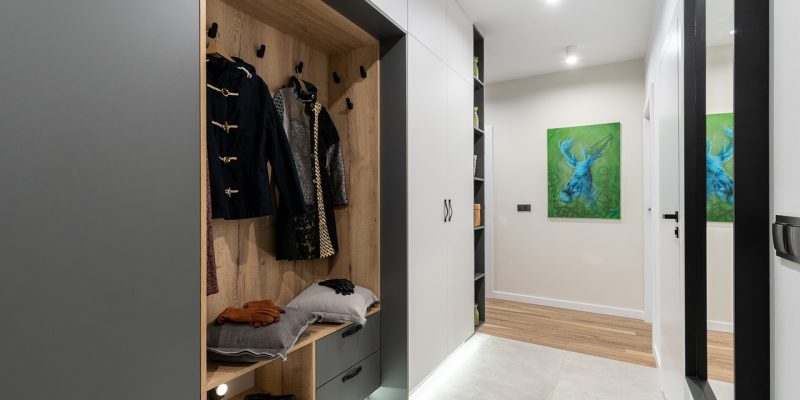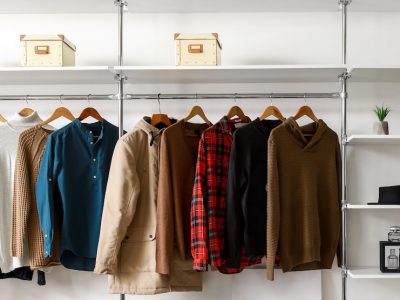Small closets can seem like a big problem. Limited space challenges us to think creatively and organize efficiently. But with the right strategies, even the tiniest closets can transform into tidy, functional spaces. We’ll explore the best way to organize a small closet, turning clutter and chaos into order and accessibility. By following these practical tips, you’ll unlock the potential of your small closet and make the most out of every inch.
Prioritize and Purge: The First Step to Closet Freedom
Embarking on the quest for an impeccably organized small closet necessitates beginning with a crucial, albeit sometimes challenging, step: decluttering. This process is fundamental in determining what genuinely deserves a spot in your limited space. Take a moment to evaluate each piece of clothing, accessory, and miscellaneous item stored in your closet. Pose the question: Does this item spark joy, serve a practical purpose, or is it essential to my daily life? If the response fails to affirm any of these criteria, it may be time to consider parting ways with it.
This act of prioritizing and purging paves the way for a more organized and accessible closet. Items that no longer fit, are out of style, or haven’t been used in the last year are prime candidates for donation or recycling. Similarly, seasonal attire and accessories not currently in use can be stored elsewhere to optimize the available space.
By rigorously editing your belongings, you create room to breathe and design an organizational system that is both functional and aesthetically pleasing. This initial step, though it may seem daunting, is essential in achieving closet freedom and lays the foundation for a more orderly and efficient storage area.
Utilize Vertical Space to Your Advantage
Leveraging vertical space is a game-changer in the organization of small closets. One innovative approach is to add shelving units above the existing closet rod, effectively doubling your storage area for less frequently used items such as out-of-season clothing or spare bedding. Stackable bins and boxes are perfect for categorizing and segregating items, ensuring everything has its designated spot, from winter gloves to summer hats.
Don’t overlook the potential of wall-mounted hooks and racks. These can be installed on any free wall or behind the closet door to hang items like necklaces, ties, or even small handbags, thereby freeing up shelf and rod space for larger items. For footwear, consider a slim, vertical shoe organizer that aligns neatly against the closet wall, minimizing floor clutter.
Hanging organizers present another versatile solution. Available in a variety of sizes and configurations, they can store anything from shoes to sweaters, making effective use of the closet’s height. Their soft-sided design is particularly advantageous for squeezing into tighter spaces without sacrificing storage capacity.
By embracing these strategies to capitalize on vertical space, you transform previously underutilized areas into valuable storage. This approach not only enhances the closet’s functionality but also its accessibility, ensuring you can easily reach and retrieve items without hassle. Through creative installation and strategic use of space-saving products, the full potential of your closet’s vertical dimensions can be unlocked, yielding a more organized and clutter-free environment.
Embrace the Magic of Multi-Function Storage Solutions
In the realm of small closet organization, multi-function storage solutions emerge as invaluable allies. These ingenious items not only conserve precious space but also enhance the closet’s overall utility. Consider investing in furniture pieces that serve dual purposes, such as a bench that opens up to reveal storage space ideal for housing seasonal items or bulky sweaters. Similarly, over-the-door organizers offer a sleek, space-saving option to store an array of items from shoes to accessories, making every square inch work harder.
For those seeking to streamline their closet further, look into specialized hangers designed to hold multiple garments, such as tiered hangers for pants or scarves. These hangers reduce the need for space while keeping items easily accessible and wrinkle-free. Drawer dividers also play a critical role in maximizing drawer space; by compartmentalizing your storage, you can keep smaller items like socks, underwear, and accessories neatly organized and readily at hand.
Don’t underestimate the versatility of adjustable shelving either. These can be rearranged to fit your changing storage needs, accommodating everything from a high stack of jeans to a collection of hats. By incorporating these adaptable storage solutions, you not only optimize your closet space but also keep your belongings in a state of perfect order. The objective is to select storage options that adapt to your lifestyle and evolve with your wardrobe, ensuring your small closet remains a model of efficiency and organization.
The Importance of Cohesive Hangers and Uniform Folding
Achieving an aesthetically pleasing and space-efficient small closet begins with a simple yet impactful change: the uniformity of hangers and folding techniques. Opting for a single style of hanger not only elevates the visual harmony of your closet but also contributes significantly to space conservation. Slim-profile hangers, for instance, allow more garments to be stored in the same amount of space, compared to their bulkier counterparts. This choice eliminates unnecessary bulk and ensures a neater presentation of your attire.
Equally important is the consistency in how clothes are folded. Establishing a uniform folding method for items placed on shelves or in drawers does wonders for both the appearance and functionality of your storage spaces. This practice enhances the neatness of stacked garments, making it easier to identify and retrieve what you need without disrupting the arrangement. Moreover, a standardized folding system maximizes the use of available shelf space, accommodating a larger quantity of clothing in a more organized manner.
Together, cohesive hangers and uniform folding act as foundational elements in the optimization of closet space. By implementing these strategies, you create a visually appealing environment that also maximizes the functional use of every inch within a small closet. This disciplined approach to organization aids in maintaining a clutter-free and efficient wardrobe area, streamlining the process of selecting outfits and managing your clothing inventory.
Make Seasonal Swaps a Routine Practice
Adopting the habit of rotating your wardrobe with the changing seasons can drastically enhance the functionality and organization of a small closet. This practice involves relegating off-season attire to alternative storage areas, such as vacuum-sealed bags tucked under the bed or in a separate storage bin. By doing so, you not only declutter your closet but also make room for the current season’s essentials to take center stage.
Initiating this process twice annually, during the transition into warmer or cooler months, ensures that your closet remains aligned with your immediate needs. It’s also an opportune moment for a mini decluttering session. As you sift through your garments to decide what stays and what gets stored away, evaluate each piece’s relevance and condition. This is the perfect time to let go of items that no longer fit, are worn out, or haven’t been worn in the past season.
Additionally, this seasonal rotation encourages you to reacquaint yourself with pieces you might have forgotten, potentially revitalizing your wardrobe without the need for new purchases.
Embrace this cyclical closet refresh as a strategic move towards maintaining an organized, spacious, and functional wardrobe year-round. By systematically adjusting your closet to match seasonal requirements, you not only optimize available space but also keep your wardrobe fresh and exciting, all while minimizing clutter and maximizing accessibility.
Label Everything for Ease of Access
Labeling emerges as a powerful tool in the quest for an effortlessly navigable small closet. Allocate distinct labels for your containers, baskets, and even individual shelves to outline the designated homes for different categories of belongings. This tactic shines in its ability to streamline the search for specific items, eliminating the need for prolonged searching and digging through piles. It’s particularly advantageous for those possessions stored higher up or in less immediately visible locations, ensuring a smooth retrieval process.
Incorporating labels also fosters a disciplined approach to returning items to their rightful places, thereby maintaining the established order within the closet. This is especially useful in shared spaces, where multiple users can benefit from clear, visible guidance on where to place items post-use. Consider employing various labeling techniques, such as handwritten tags for a personal touch or printed labels for a sleek, uniform look. For a modern twist, QR codes linked to digital inventories of box contents can offer an innovative and detailed organizational method.
Moreover, labels serve as a gentle reminder of the need to adhere to the categorization system set in place, supporting the ongoing effort to keep your closet organized. They can be easily updated or changed, offering flexibility as the contents of your closet evolve over time. By integrating this simple yet effective strategy, you enhance not only the functionality of your small closet but also its accessibility, making the daily task of choosing outfits and locating items a hassle-free and enjoyable experience.
The Role of Lighting in Closet Organization
Enhancing your small closet with the right lighting is a transformative step often underestimated in its capacity to elevate organization and accessibility. A well-lit closet not only simplifies the task of locating and selecting items but also instills a sense of openness within a confined space. Consider integrating a variety of lighting options, such as LED strip lights along shelves and rods or motion-sensor lights that illuminate the space upon entry. These modern solutions are not only energy-efficient but also minimize the hassle of manual operation, making your closet more user-friendly.
The strategic placement of lighting fixtures can also highlight areas of the closet that tend to be overlooked, ensuring every item is easily visible and within reach. This is particularly beneficial for deeper closets where corners might not receive ample natural light.
Additionally, the type of lighting chosen can affect how the colors and textures of your clothing appear, helping you make accurate outfit choices that match well in different lighting environments outside your closet.
Investing in quality closet lighting might require some initial effort and expense, but the payoff in daily convenience and enhanced functionality is immeasurable. By shedding light on your wardrobe, you not only make it easier to maintain an organized closet but also create a more enjoyable and efficient dressing experience. Whether you’re getting ready for the day or planning outfits for a trip, a properly lit closet becomes a valuable ally in your daily routine.
Regularly Reevaluate Your Closet Organization
Maintaining an organized small closet is an ongoing process that requires periodic assessment and adjustment. As life progresses, our wardrobe needs and preferences evolve, necessitating a fresh look at how our closet is organized. Set aside time every few months to take a thorough inventory of your closet’s contents and the effectiveness of your current organization system. Ask yourself which areas are functioning well and which could use improvement or a complete overhaul. This continuous evaluation process allows you to adapt your organization strategy to suit new purchases, lifestyle changes, or shifts in fashion preferences.
During these reevaluation sessions, consider experimenting with different storage solutions or rearrangement ideas that could enhance accessibility or create additional space.
For example, if you find that certain items are consistently difficult to locate or that some storage accessories are underutilized, it might be time to try a new approach. Keeping an open mind and being willing to adjust your tactics can lead to innovative solutions that better match your current needs.
Embracing this habit of regular reassessment not only ensures that your closet remains a functional and pleasant part of your daily routine but also prevents the accumulation of clutter, making it easier to keep your space organized and tidy over time.













Comments